Nooruz – the Muslim adaptation of the
vernal equinox into a religious celebration [wikipedia entry] – fell on Friday, and as such, we had a three day weekend. Eight of us
(me, J, N, K, A, JW, B and M) decided to make the trip down to Naryn (a town of
about 50,000 people located 2000 meters above sea level and five hours
south-east of Bishkek) for the long weekend. We booked everything via CBT and they were awesome and super cheap.
Friday morning we left the London School at about 9:30, and took two taxis to the bus station. Public transportation in Kyrgyzstan is, sadly, pretty crappy, and CBT had advised us to go to the bus station and hire taxis to take us to Naryn. They also advised us that a taxi to Naryn would run approximately 1500soms. The driver of the taxi taking us from the school to the bus station immediately started trying to get us to agree to a “special deal” of “only” 5000soms (over $100) for a taxi to Naryn. Obviously, he assumed that because we were foreigners we would have that kind of money and wouldn’t realize we were being ripped off. Unfortunately for him, we stood our ground. We arrived at the bus station and were immediately mobbed by a group of taxi drivers, all vying for the opportunity to drive us to Naryn. We were successfully able to secure two taxis for the price of 1500soms each.
Leaving Bishkek, the weather was gorgeous, as was the scenery once we left the polluted and smoggy air of the city.
Friday morning we left the London School at about 9:30, and took two taxis to the bus station. Public transportation in Kyrgyzstan is, sadly, pretty crappy, and CBT had advised us to go to the bus station and hire taxis to take us to Naryn. They also advised us that a taxi to Naryn would run approximately 1500soms. The driver of the taxi taking us from the school to the bus station immediately started trying to get us to agree to a “special deal” of “only” 5000soms (over $100) for a taxi to Naryn. Obviously, he assumed that because we were foreigners we would have that kind of money and wouldn’t realize we were being ripped off. Unfortunately for him, we stood our ground. We arrived at the bus station and were immediately mobbed by a group of taxi drivers, all vying for the opportunity to drive us to Naryn. We were successfully able to secure two taxis for the price of 1500soms each.
Leaving Bishkek, the weather was gorgeous, as was the scenery once we left the polluted and smoggy air of the city.
We drove eastward along a road just south
of the Kyrgyzstan/Kazakhstan border; we were so close that had we been
adventurous enough we could have walked to Kazakhstan.
Much of the way we followed the same route
we traveled on our trip to Issyk-Kul in February. We passed the sacred spring
– still guarded by the same dog, who seemed to be doing
quite well for herself. We also passed an area where different companies had
displayed their logos and/or slogans on the mountainside by using white stones.
I managed to snap a shot of MercyCorps Компаньон (where I teach my morning
class), displayed on the mountainside.
East of Balykchy, we stopped at a pit-stop area near Kok Moynok for a bathroom break, and for our driver to get some lunch. At that point we turned away from the route to Issyk-Kul, and began heading south towards Naryn. This route took us up into the mountains along narrow, winding roads (often littered with herds of sheep, cattle and horses), which wound past the Orto-Tokoy Reservoir, past the village of Kochkor, and up towards the Dolon Pass. Our driver flew along these narrow roads at an incredible pace, and quite often we were somewhat worried that we would die. But we didn’t, obviously. And we managed to avoid running over any animals along the way as well.
We arrived in Naryn around 3:00 (my taxi made it there about 30 minutes faster than the other taxi, on account of our driver being slightly homicidal and all), and made our way to our apartment, which we had booked through CBT. When we booked our apartment, we’d been given two options: one place was 350soms/night/person while the other was 450soms/night/person. When we asked what the difference between the two was, we were told, “Quality, of course!” Being poor and cheap, we went with the 350soms option, and I’m glad we did. I can’t imagine what that extra 100soms would have gotten us. We were in a huge apartment with five bedrooms (several of which had balconies) and eight beds, two bathrooms and a large kitchen/dining area. It was all clean and nice – and we got breakfast included! Additionally, the fellow who was our host was very friendly and helpful. I definitely recommend booking apartment stays through CBT after this!
East of Balykchy, we stopped at a pit-stop area near Kok Moynok for a bathroom break, and for our driver to get some lunch. At that point we turned away from the route to Issyk-Kul, and began heading south towards Naryn. This route took us up into the mountains along narrow, winding roads (often littered with herds of sheep, cattle and horses), which wound past the Orto-Tokoy Reservoir, past the village of Kochkor, and up towards the Dolon Pass. Our driver flew along these narrow roads at an incredible pace, and quite often we were somewhat worried that we would die. But we didn’t, obviously. And we managed to avoid running over any animals along the way as well.
We arrived in Naryn around 3:00 (my taxi made it there about 30 minutes faster than the other taxi, on account of our driver being slightly homicidal and all), and made our way to our apartment, which we had booked through CBT. When we booked our apartment, we’d been given two options: one place was 350soms/night/person while the other was 450soms/night/person. When we asked what the difference between the two was, we were told, “Quality, of course!” Being poor and cheap, we went with the 350soms option, and I’m glad we did. I can’t imagine what that extra 100soms would have gotten us. We were in a huge apartment with five bedrooms (several of which had balconies) and eight beds, two bathrooms and a large kitchen/dining area. It was all clean and nice – and we got breakfast included! Additionally, the fellow who was our host was very friendly and helpful. I definitely recommend booking apartment stays through CBT after this!
After settling into our new digs, we took a
taxi into the center of Naryn. And by “a taxi” I do mean just one, for all
eight of us. We found a station wagon taxi, and convinced the driver that it
was really OK for three of us girls to squish into the back part under the
hatch, even though he seemed to think it was a bit absurd.
We were hoping that Nooruz celebrations
would still be underway in downtown Naryn, but unfortunately, by the time we
got there, things were essentially winding down. Most of the people had left
the main square, and while some of the decorations for the holiday remained up
all weekend, many were being taken down when we arrived. However, there was
still a very bizarre set up where for just 20soms you could have your picture
taken, which A did:
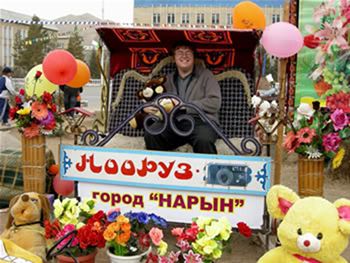
There were all sorts of other bizarre
attractions which were in the process of being dismantled when I arrived,
including an annoyed looking horse, many stuffed (as in taxidermied) sheep and
goats, and a giant stuffed yellow M&M, which really didn’t fit in at all.
From the central square of Naryn, located essentially at the base of the
mountains, we could look up and see a Kyrgyz Muslim cemetery located in the
foothills. We decided to climb to said cemetery. It wasn’t that far or that high
of a walk, but by the time I reached it, I was feeling incredibly light-headed
and dizzy. Must’ve been the altitude.
After exploring the cemetery, we decided
to keep hiking up the slopes. We hiked for quite a way, until we reached a
point where we had a stellar view of the city. The city of Naryn is long and
skinny, as it is located in a valley along the Naryn river.
We finally reached the top of the last
snow-less hill, at which point I could barely breathe, was incredibly dizzy and
was starting to see black spots. We rested for a while, then took a bunch of
crazy photos in front of the cool Naryn valley backdrop.
At that point, some of the group wanted to
continue hiking up into the snowy mountains. However, I figured I would pass
out if I continued any further, so JW and I went back down the mountain. From
the city center, we took some shots of the mountainside, and upon zooming in,
were actually able to spot the specks which were K, J, and N, struggling up the
mountainside in a line.
JW and I decided to walk down to the Naryn
River. Along the way we found the Russian Orthodox cemetery. Naryn is
essentially devoid of Russians these days (I saw only one ethnic Russian the
entire weekend), and while most people seem to speak a smattering of Russian,
Kyrgyz is definitely predominant. Obviously there was once a large Russian
population in Naryn, as evidenced by the large Orthodox cemetery; however, the
cemetery was in disrepair and thoroughly littered with trash. One might say the
locals were making some kind of statement.
We approached the river (avoiding a violent, wolf-like dog), and ran into a
group of pre-teen boys. They asked me to take their picture, and were utterly
thrilled when I did. We didn’t actually make it to the shore of the river; the
way down was blocked by a group of drunken Kyrgyz men and we weren’t sure how
they’d react to the appearance of two foreigners. It probably would have been
fine, but we didn’t want to chance it. We decided to head back into the center,
where we met up with A, B and M at Restaurant Corona. (K, J, and N were still
climbing the mountain.) Corona was a good restaurant – tasty food, super cheap.
I definitely recommend it. It’s located a couple blocks east of the central
square, on the left side of the road if you’re headed east.
The next morning we had arranged via CBT for two cars to drive us from Naryn to
Tash Rabat, a stone fortress/caravanserai dating from either the 13th or 15th century (depending on the
source), which was once a prominent stop on the silk road. Tash Rabat is only
about 60km from Naryn; however, due to the quality of the roads, the trip takes
about two to two and a half hours. The main road heading from Naryn to the
Torugart Pass (leading over the border into China) is traveled daily by
numerous semis bringing goods into Kyrgyzstan from its large neighbor. This
makes driving interesting, as inevitably both your car and the approaching semi
will be driving down the center of the narrow road as quickly as possible!
Eventually, you will turn off the main road to China, and take a small
dirt/gravel track to your left. Soon you will have to ford a river. The remains
of a “modern” bridge can still be seen, although it collapsed several years ago
and has yet to be repaired. Depending on the season, the river can be
un-crossable in all but the largest, sturdiest of vehicles. Luckily for us, the
snows had only just begun to melt, and we were able to ford the river with no
problem.
After fording the river, you will continue up the Tash Rabat valley, following
the course of the river. In theory, one should be able to travel by car all the
way to the fortress of Tash Rabat itself. However, here in Kyrgyzstan, one
should realize that just because something is true “in theory” doesn’t mean it
will occur in fact. We drove along the river into the Tash Rabat valley. The
river was frozen on the surface yet thawed and flowing underneath. Eventually,
we came to a place where the road passed across the surface of the ice for a
good fifty meters or so. We were almost across when the ice gave way. Forward
momentum ceased and the car simply sunk. There was a moment of silence before
our driver said: Uh-oh.
The driver told us that we were within
walking distance of Tash Rabat. (K and I swear he said 100 meters, while N and
J heard 1000 meters. I’d say it turned out to be more like 3000 meters, but
it’s hard to know.) Anyway, the driver told us to walk on ahead, saying that
he’d wait for the second car, and that he and the other driver would be able to
get the car un-stuck. So off we walked down the valley.
As we approached every bend, we were
convinced Tash Rabat would be around the next corner. Tash Rabat is located at
an elevation of roughly 3500 meters – a good deal higher than we’d been the day
before – so the thin air made us all quite giddy. Luckily, I didn’t have nearly
as bad a reaction to the altitude as I’d had the day before. I simply felt
silly. At one point K and I were even making up a song to the tune of Rock the
Casbah, singing rockin’ the Tash Ra, rock the Tash Ra. Yeah.
Thin air. When we finally rounded the corner and saw the fortress in the
distance, we let out quite a cheer.
As we approached Tash
Rabat, we noticed a shepherd watching us. He came down from the field and
entered the homestead directly across the track from Tash Rabat. K and I,
having arrived first, sat down to await the rest of our compatriots. A woman
soon emerged from the homestead and ambled over to us. She and her husband were
the caretakers of Tash Rabat. We were invited in for tea, and told that it
would be 50soms/person to enter the fort and that for 100/soms, we could have
soup. Their farm was fabulous – especially since it was home to a dog, a donkey
and a cat, all of whom were incredibly adorable and friendly, AND it was packed
with cute little lambs. We tried not to think about the fact that they’d be
somebody’s dinner someday as we played with them.
We rested and had tea as we waited for the rest of our party to arrive. When we
were all assembled, we made our way over to Tash Rabat. The old fortress was
interesting, and had a splendid view of the valley. It was filled with many
chambers, some of which still bore the remains of the original decorative plasterwork.
After thoroughly exploring all the nooks,
crannies and chambers of the caravanserai’s interior, we climbed up atop the
roof for more photography ops.
After deciding we’d had enough time
rockin’ the Tash Ra, we headed back to the homestead for some yummy sheep and
potato soup, and some more quality time with the farm animals. Then we learned
that there was someone with a car on the Tash Rabat side of the ice, who was
willing to drive us back to where we’d left our cars. Since there were eight of
us, he had to take us in two shifts. I was part of the first shift. Our driver
was young, into absurdly fast driving and crazy loud music – which was both
awesome and frightening, given the road quality and all. Nonetheless, we made
it back to our cars in record time.
While waiting with our drivers for the second shift to arrive, a man rode up on
a horse. He wore desert camouflage, had a shotgun strapped to his back and wore
shotgun shells around his waist. We called him the Kyrgyz version of Walker,
Texas Ranger. He and one of the drivers began testing the ice in different
places (by jumping up and down and stomping) to see if they thought a car could
pass over anywhere safely. Apparently, our fast moving, loud-music-playing
driver wanted to get across. While they were busy stomping on the ice, Walker
Kyrgyz Ranger’s horse simply wandered off. I told him his horse was leaving,
and he replied that it was okay; they lived nearby and it was simply going
home. He began talking to me and K... and then offered me five yaks to become
his second wife! I wasn’t too clear on whether he’d be shipping the five yaks
to my father (which would actually be quite an endeavor) or if he’d simply be
assigning me five of his yaks to take care of. Either way, I declined. But now
we know I’m worth five yaks. (I later learned that the going bride price in the
area is about 200 yaks, which made me feel a tad undervalued!)
After both car loads of people had been
reunited, we began our trip back to Naryn. However, it wasn’t a straight trip.
We stopped along the way at the ruined citadel of Koshoy Korgon, located in the
village of Kara-Suu. Not much is known about this fortress (at least according
to my guidebooks, anyway) but it dates from roughly the 10th century, and was
probably Karakhanid. All that remains of this once grand citadel are crumbling
earth walls, which are both desolate and majestic.
After that, we drove back to Naryn. We
reached the city feeling exhausted and hungry. We asked our host if there were
any good cafes near our apartment; he said no, the only good ones were in the
center. As we weren’t feeling much like trekking into the center of town for a
meal, we decided to settle for whatever mediocre fare could be had at a café
near our apartment. We really should’ve gone back to the center and eaten at
Corona again. Ahh well. The café we went to was called Улан (Ulan). The
waitress handed us menus and then proceeded to tell us which items on the menu
were available and which weren’t. Essentially, most of what was on the menu was
unavailable. We ended up all ordering a dish called Улан, like the restaurant,
which was supposed to be some kind of meat and cheese dish. When our food was
brought out, we were told that they were out of cheese, so they’d substituted
pilmeni instead! (For those of you who don’t know, pilmeni are kind of like
dumplings, stuffed with a usually unidentifiable meat product... not exactly
what I’d think of as a cheese substitute!) This bizarre conglomeration had
apparently been fried in egg, then slathered in mayonnaise and Central Asia’s
bizarre equivalent to ketchup. Let’s just say that if you’re ever in Naryn, eat
at Corona and avoid Улан.
The next morning, we decided that we wanted to go see the mosque. While there
are several mosques in Naryn, there is one that is known as being quite
picturesque and which appears in all the guidebooks. We got up early in order
to have time to see the mosque and wander about the city some more before
returning to Bishkek. Outside of our apartment was an unfinished structure of
some sort, which was obviously used by everyone in the neighborhood as a
dumpster; it was filled with trash. And cows. The cows were grazing on the
trash. It was really a pathetic sight. We all stopped to take photos of the
trash-eating cows, and were approached by an elderly Kyrgyz man. At first I
thought that perhaps they were his cows, and that he would be really upset that
they were eating trash and chase them on home. Sadly, that was not the case. He
told us that the people of Naryn are lazy: they need cows in the city for milk
and food, but they are too lazy to take them to pasture to graze, so they just
let them wander the streets. He agreed with us that it was horrible and that it
would make the milk and meat taste bad.
After parting ways with the old man and
the sad, trash-eating cows, we walked down to the part of the Naryn river
closest to our apartment. It was really quite scenic, although sadly, the
lighting at that time of day wasn’t exactly conducive to brilliant pictures.
Then we caught taxis to the mosque. JW,
who speaks Kyrgyz, negotiated the taxi for us, telling the driver to take us to
“the new mosque built by the Saudis.” Then JW stayed with the second group to
negotiate a second taxi. Little did he know that since the construction of the
mosque which we wanted to visit, the Saudis had built yet another mosque in
Naryn, at the opposite end of the city. Anyway, M, Nick, J, and I were all
squished into a taxi, speeding down the narrow main street of Naryn at a
frightful pace, when we whizzed past the mosque which we knew to be our
destination. Now, while Kyrgyz is the main language spoken in Naryn, up to that
point we’d had no trouble communicating in Russian when we needed to. So we
asked the driver to stop. Repeatedly. He completely ignored us. At that point JW
phoned, to say that there was a second new mosque built by Saudis, and that our
driver was probably taking us there. We decided to have JW talk to the driver,
so we handed him the phone – the driver looked at it for a second then handed
it back without even talking to JW! At that point we were getting a little
worried/frustrated. Luckily, M speaks Turkish quite well. Kyrgyz is a Turkic
language, and as such, is quite similar. He was able to convince the guy to
stop and turn around. Very frustrating. I need to learn how to say “Stop please!”
in Kyrgyz!
We didn’t stay long at the mosque, just long enough to wander about and take
some photos. I don’t know anything about it, other than it was built by the
Saudis in 1993, and that it’s in the shape of a kalpak, or Kyrgyz hat, which
makes it pretty unique architecturally.

After exploring the mosque, the boys
decided they wanted to go to the bazaar, which the girls and I decided to make
for a cemetery which we’d seen on the outskirts of the city on the road to Tash
Rabat. We flagged down a taxi driver, who seemed to think we were pretty insane
by our choice of destination, but who took us there quickly and cheaply. The
cemetery was in an incredibly scenic spot, on the hills below the mountains and
only a little ways above the town. The graves were fascinating – especially a
couple which had obviously been excavated! (These weren’t old graves, so one
wonders why the occupants had been disinterred. Additionally, the disturbed
graves were at the rear of the cemetery, so perhaps the relatives of the dead
are unaware of this destruction...)
As we were preparing to leave the cemetery, we heard the plaintive crying of a
sheep. We looked out over the hills to see a solitary sheep, its herd several
hillsides away. We called out to it in our version of sheep-speak: Over
the-eh-eh-eh-r! Туд-а-а-а-а! Unfortunately, it decided we were its herd, and it
ran to us at full speed. Of course, when it reached us and found that we were
three humans and there were no sheep in sight, it began to cry again. It was
incredibly pitiful to hear.

We descended from the hill on which the
cemetery was situated and crossed the road to explore a small stream. The sheep
came down from the hill too, and watched us from across the road. When we began
to walk back towards the city, so did the sheep. We were very worried that the
sheep was going to follow us all the way back to the apartment, but it was not
to be. The sheep spotted a small bridge across the creek, leading to a small
farm, and it ran across with glee, baaing triumphantly. We felt all warm and
fuzzy, thinking we’d led the lost sheep back to its home. The sheep approached
a cow and chicken looking relieved to be at home, and we imagined it saying,
“Cow and chicken! I’m back! It’s so good to see you! I’ve had the most wonderful
adventure!” But our gleeful anthropomorphism was crushed when an old Kyrgyz man
came running out of the farmhouse, shouting and waving a stick, which he then
used to beat the sheep. As the sheep ran away, he hurled the board after the
poor thing. It scampered off into the distance, and we don’t know if it met up
with its herd again or not.
We walked back into town and spent the next hour or so wandering the city,
sitting in the square drinking tan (it’s vaguely like carbonated buttermilk)
and eating Cadbury creme eggs (which had been sent to us for Easter) then went
back to the apartment to prepare to leave. CBT Naryn helped arrange a private
marshrutka to drive us all back to Bishkek. I stayed awake all the way back,
and was able to enjoy the driver’s frightening maneuvers as we blasted through
the 3000+ meter Dolon Pass.
After descending from Dolon, we stopped at the village of Kochkor, where CBT
runs a shop which sells shyrdaks (traditional Kyrgyz woolen rugs), handmade by
local women. I bought one which is brown, white, lime green and turquoise, and
utterly awesome. Unfortunately, I have to keep it locked away because the cats
want nothing more than to tear it to shreds. Must smell like dead sheep.

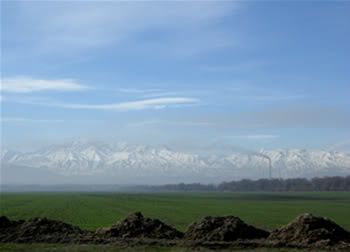

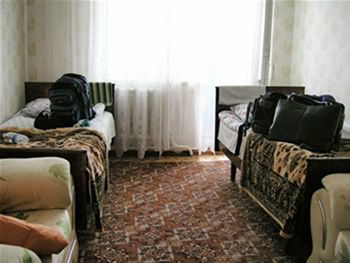
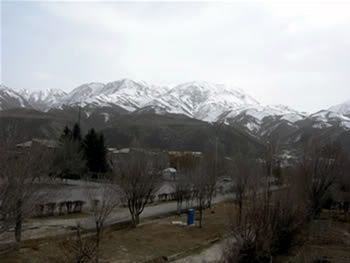
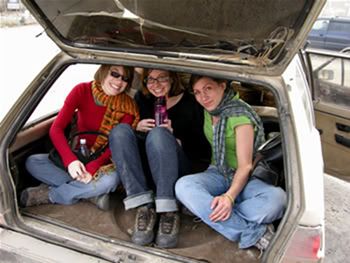
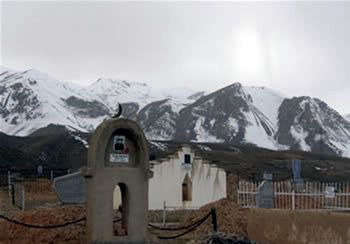
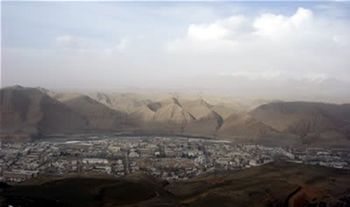
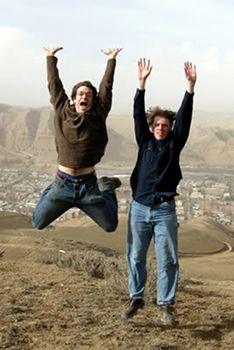
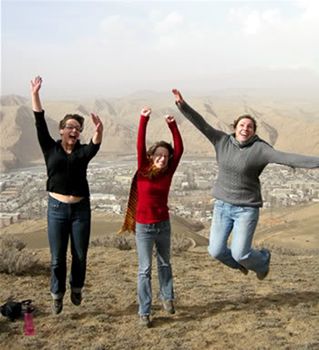
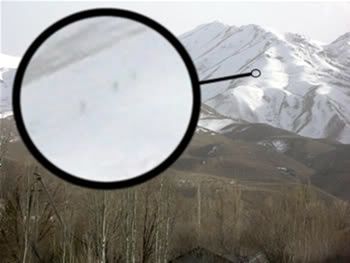
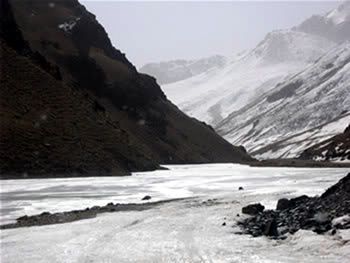
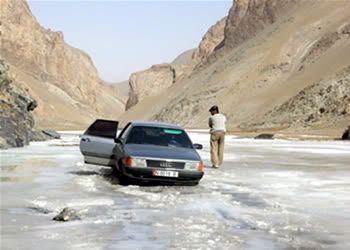
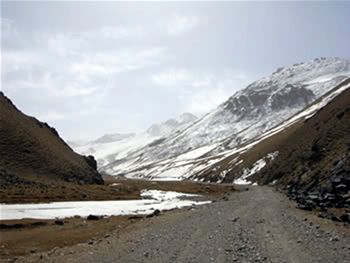
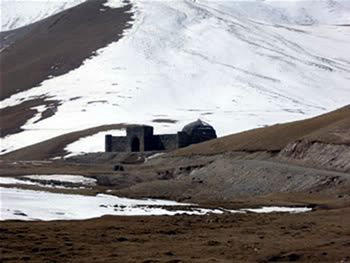
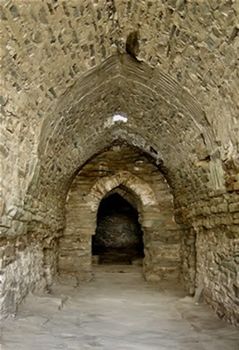
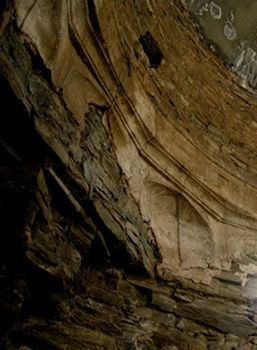

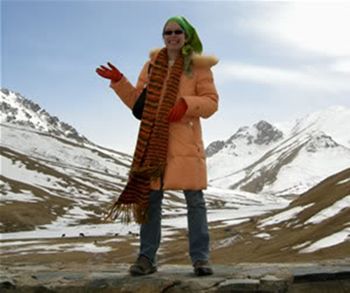

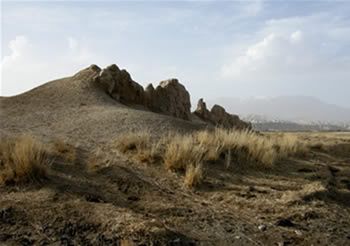
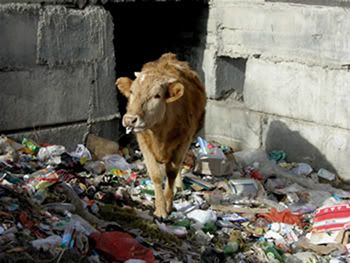
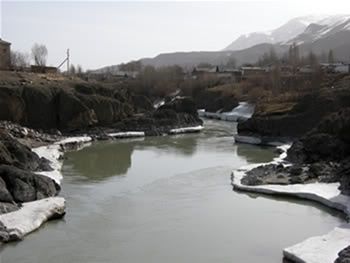

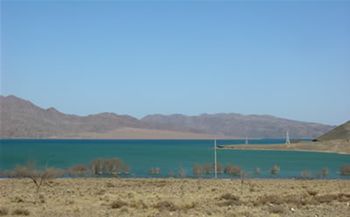
No comments:
Post a Comment